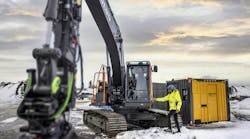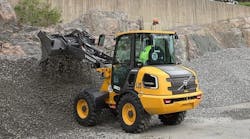"I was here yesterday, and the reason I came back out here today is because I was thinking this was a dream," says Valverdini, a veteran finish blade operator and member of the International Union of Operating Engineers. "It's not a dream; it's true. It is very impressive how much different this system is compared to other systems.
"Construction companies need to come here personally and see how much production, how much difference, this system offers."
Leveraging the established Global Positioning System (GPS) technology for location, the 3D-MC2 system introduced at Conexpo-Con/Agg 2008 adds new sensor technology — a combination of inertial sensors and gyros — that calculates and updates such information as blade tilt, machine position in every direction, and instant change in direction, at a rate 10 times quicker. The result is what Topcon Positioning Systems has touted as an increase of 200 percent or more in smooth grading speed for dozers. It earned Topcon not only a Construction Equipment Top 100 Product award in 2008, but also an Editor's Choice award.
This year, officials with Topcon have been welcoming site-prep contractors to do a little fine dozing with the 3D-MC2 system at a site near the company's North American headquarters in Livermore, Calif.
"We had an owner-operator out there on the John Deere 750," says Tony Vanneman, Topcon's construction products marketing manager. "He had it in automatic, he was cutting pretty good grade, but I kept encouraging him, 'You've got to go faster, my man: drop it out, speed up, increase your rpm!' The next couple of passes, he finally did, and it ended up that literally you could see the shiny spots on the grade it was so smooth. And the operator was just grinning like a Cheshire Cat.
"It's been a lot of fun just to see the reactions of people when they get in the seat and see it for themselves. Looking at videos and testimonials is great, but for a guy who's used to moving dirt for a living to get to experience this, it makes all the difference in the world."
Click Image To EnlargeGrading at a high speed with a dozer? Spartakoos Valverdini didn't think it was possible, but he does now after spending a couple of days on a John Deere 750J crawler dozer equipped with Topcon's 3D-MC2 machine control system.Sure enough, on his second day with the 3D-MC2 system, Valverdini was more than pleased to show what the 33,000-pound, 145-horsepower Deere 750J crawler dozer could do. While grading at full machine speed, something he never imagined a mid-sized dozer not particularly heavy doing in the first place even with the most veteran of blade hands, he proceeded to raise both his hands for a couple of hundred feet, showing it was not his touch leaving the smooth grade behind.
"The automatic system told me, 'You're good with your hands; I'm better," says Valverdini, a retired U.S. Marines colonel and former Apache helicopter pilot. "I made a couple of passes with my hands and then later I used the automatic system, and I saw how much different the finish is. A good operator to put down a grade like that needs to make six, seven passes; with that system, it's only one pass and you're finished." He had no intention of looking around for a grader. "With that machine, you don't need a blade."
During a walk-around display for potential customers, John Dice says the 3D-MC2 system turns a dozer from a reactive to a proactive earthmover.
"The bulldozer by its own nature is kind of difficult to operate, from the perspective that you have a cutting edge that's out in front," says Dice, Topcon senior training manager. "Having that cutting edge in front, and then the machine itself walking on top of the dirt, makes it a little bit more of a challenge for an operator to actually cut a very nice, smooth grade. It's not a grader."
| Topcon's John Dice explains to a group of operatiors how the company's 3D-MC2 system works. |
Dozers equipped with standard GPS technology for three-dimensional machine control, by which the exact cutting edge position is determined via an antenna on the moldboard and sent back to the operator's control box where the job design is housed, must relinquish machine speed for any work finer than rough grading, he says. With updates 100 times per second, "by the time we get a measurement position and it gets up to our control box, this blade has moved several inches potentially, before it actually reacts. Because of the nature of the dozer, that's really too late." Hence, standard machine control, while offering accuracy advantages, may force work speeds not all that different from a machine being operated manually.
With 3D-MC2, the system's compass works with three inertial sensors measuring motion movement and three electronic gyroscopes measuring position to update, "at a rate of a hundred times a second," says Dice. "So, basically instantaneously we are measuring the roll, pitch and yaw, and the acceleration rates of the movement of this cutting edge. We're going to use GPS to give a position, but once this knows its position, then any immediate movement that happens, this can instantaneously measure that accurately. We're really not using GPS to control the machine; it is the primary sensor that controls the machine."
The impression may be, he says, "this is the way it ought to work. Well, it is not the way that traditional GPS works."
"Especially on the dozer," explains Vanneman, "because of the physics on the machine, because of the update rate of their regular GPS machine control and because of their previous slope sensor technology, we couldn't often get good grade at a higher operating speed. Now we get the superior grade at a much higher operating speed with the new inertial sensor technology."
Representing the Pavex Construction Equipment division of San Jose-based Graniterock, Dan Enachioaie was on site the same day as Valverdini to check out 3D-MC2, not so much however from an operating perspective, but rather a management one. His employer's fleet has machines equipped with other makes of machine control systems, and he needs to know 3D-MC2 is economically viable before he can recommend further consideration. Much of his focus was on the control box in the operator's station, "and the ease of use is a plus for me," he says. "I like the way they set up this machine from an ease-of-use perspective. When it comes to the finished product, meaning the grade that this machine cut, it's very, very good."
"There are many other factors that would determine the success or failure of a system, but it is something we will probably consider."
Machine control allows the operator to "start managing his material," says Dice. "He doesn't have to worry about the grade positioning at the speed and the rate of whatever it is he is doing." In a non-digging application like spreading stone, for instance, the question now becomes, "How fast can this machine go?"
That's really what sets 3D-MC2 apart, says Vanneman. "Until you hear a contractor say that it's twice as fast, it's five times as fast, and these guys are spending their hard-earned money on it, it's almost hard to believe," he says. "It almost sounds too good to be true, but it's not. This is the real deal."
Valverdini says he has seen enough: "This is amazing."





